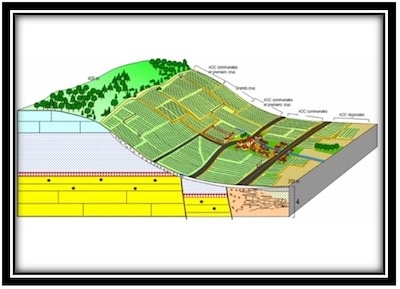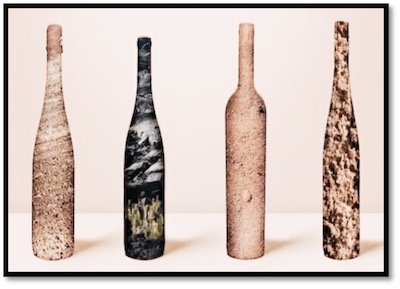CLOSED EASTER SUNDAY // HOURS: TUESDAY-SATURDAY 12-6PM, SUNDAY 11-5PM
Vol. 27 - "Terroir or Climat?"
 Click here to read the original PDF-formatted article
Click here to read the original PDF-formatted article
TERROIR OR CLIMAT?
Letter to Mr. Bob
Book of Bertil 27.01

Preamble:
A few months ago, I invited a very important American winemaker to Bonde Fine Wine Shop to "Faire Salon"* for a discussion about his eco-responsible wines and current winemaking in the United States. This winemaker was one of the fathers of the "Rhône Rangers" movement in the 80s, and also a pioneer of Organic and Biodynamic practices in Californian viticulture. This winemaker (who will be called "Bob" to respect his anonymity) took me aback by the answer to one of the questions made by one of the participants of the evening: "What do you think of the natural wine movement in the United States?" Bob's response: "American Natural Wines are wines without expression of Terroir, and Terroir is the main essence of a wine." Since that moment of this divine declaration, I have been turning over in my simple brain the meaning of this affirmation by asking myself the fundamental question, "Is there a Terroir of Wine in America, or only Wines of Climate?"
*Faire Salon: Someone who serves as the principal discussant or center of attention in an informal gathering of friends, peers, etc. Always around an idealistic vision (maybe not all the time!!)
Source: French expression heavily used by Madame J. Recamier in the 19th century. Recamier’s salon in Paris was one of the chief resorts of literary and political society that followed what was fashionable.
*Salon: A salon is a gathering of people held by a host. These gatherings often consciously followed Horace's definition of the aims of poetry, "either to please or to educate”. Salons in the tradition of the French literary and philosophical movements of the 17th and 18th centuries are still being carried on today.
Introduction
CHAPTER 1.0
The Notion of "Terroir"
"Behold, the days are coming," declares the LORD, "when the ploughman shall follow the reaper closely, and he that treadeth the grapes shall sow the seed, and the must shall flow from the mountains and flow from all the hills..." Amos 9:13:14
When we talk about terroir**, the first thing that comes to mind is the nature of the soil…but in viticulture, this definition is much more extrapolated and complex. For it is the interrelation, and the fusion of four very distinct elements that comprise its true nature and typicality.
**Terroir: Specifically French concept "a delimited geographical space defined on the basis of a human community that builds over the course of its history a set of distinctive cultural traits, knowledge and practices, based on a system of interactions between the natural environment and human factors". ref. UNESCO.
PS: The word "terroir" has no equivalent in other languages and is therefore often confused with the notion of territory, which is a mistake.
27.1.2 The Four Elements: Earth, Vine, and Man
So, let's take a closer look at this metaphase concept, which can sometimes seem very holistic to us poor earthlings.

27.1.2.1 The Earth in a Defined Geographical Space
The fundamental composition of a soil is the four main strata of its geological formation:
Soil: Vegetation and organic decompositions.
The subsoil: Made up of clay and mineral deposits as well as organic matter, but in smaller quantities than the upper layers.
Weathered Rock: Made up of almost unweathered rocks and very little organic matter. It is from this that the soil develops.
Bedrock: Made up of a mass of rocks such as granite, limestone, or sandstone.
Depending on the geographic location, orientation, organic history of the soils, depth, and composition, the strata will vary considerably from one specific location to another. Therefore, each geographical soil has its own constitution of mineral inputs and microelements. Each particular composition gives a very specific character to the plant organism that grows there. In addition, the older the plant, the deeper the mother roots will reach down and thus will intake minerals of different constitutions. A plant will grow well and produce quality fruit only if the soil composition (especially nitrogen) is appropriate for its particular genetic requirement (DNA). As for the lower strata (sub-soil), they will give it its sensory typicity (volume-body).
27.1.2.3 The Sky, the Climate, and the Atmosphere
To understand the importance of the relationship of a plant (the vine) in its aerial environment, it is necessary to take into consideration its geographical location and altitude in relation to the different inputs of oxygen, humidity, and relative light. Each plant will develop appropriately (flower-fruit-reproduction) thanks to the constitution of its own DNA to adapt to its specific atmospheric environment. This is why the order of plants is regulated by zones (10) and continents (6). Therefore, each vine variety needs, according to its original DNA constitution, a very particular area and altitude to produce a (reproductive) fruit of exceptional quality. In correspondence with its Latitude and Longitude location.
27.1.4 The vine:
In the plant species classification system, the genus Vitis belongs to the botanical family Vitaceae or Ampelidaceae. The generic term Vitis refers to all species of vines. Many species of wild vines grow spontaneously in North America, Europe, and Central and Eastern Asia, but it is mainly Vitis vinifera (Asia Minor) that has been domesticated and diversified into countless grape varieties. Today, there are between 5000 and 6000 varieties grown around the world.
However, other species, distinct from Vitis vinifera, are also cultivated and used to produce wine. In North America, Vitis labrusca; Vitis riparia, Vitis rupestris and Vitis berlandieri. In Central Asia, China, Korea and Japan, there are wines made from local native Vitis.
The modern science of the vine Ampelography (Science of the Ampelidaceae), dates to the 19th century, but the vine has been cultivated by humans for more than 8000 years, and its existence on earth dates back millions of years. The vine therefore adapted to its geographical environment for its survival, and this resulted in varieties of natural selection—the so-called “mother vines”.

27.1.5 The Man:
Even if man has had a relationship with Vitis Vinifiera since the Paleolithic, it was only at the time of the settlements of peoples and the increase of territorial invasions (civilization of Ancient Rome and Egypt) that the vine was selectively domesticated by man. Each settled group (social tribe) developed, by qualitative temporal deduction, the type (family-species) of vines appropriate to a specific geographical environment. The development of its new hybrids is the result of natural genetic crossing by cross-pollination of different varieties imported by humans via territorial invasion or by trade (e.g. the spice route). Then, subsequently, genetic improvement by hybridization.
So here I am at this point of clarification where the question arises:

What is the difference between Terroir and Climate?
CHAPTER 2.0
27.2.1 Terroir:
The "Terroir" thus defines the ancestral and immutable traditions of the rules and agricultural and viticultural practices of a delimited geographical area where man produces wine from vines of the same delimited geographical territory. These rules will be established and regularized (control by a third party) in a legal way to legally link a specific geographical name (designation), more or less large) to an identity and to a particular and unique style of a product (AOC-DOC-AOP-IGP). These appellations do not guarantee the quality of a wine, but rather its commercial conformity expected and understood from its legalized terroir.
So, the official definition of "Terroir" therefore represents the exclusive signature (organoleptic characteristics) of a specific wine due to the intervention of man in interaction with the soil (work, nutritional intake, etc.) in legislated relation to one or more varieties of obligatory vines (type of vine, cultivation, and viticulture) in a specific geographical climate.
27.2.2 Climate:
"Climat" is a French word used particularly in Burgundy region to define a specific geographical wine-growing area. A climat is always (or almost) enclosed in an Appellation (AOC). The climate is the perfect definition of a name given to a "Clos", which was originally an agricultural site delimited by a stone wall, which defines its cadaster. In modern viticulture, this represents the different bloc of a vineyard. Each of these parcels (blocs) expresses a particular character intrinsic to its given place name.
But if we remove the human intervention defined from a community that has built, over the course of its history, a set of distinctive cultural traits, and has established knowledge and practices, based on a system of interactions between the natural environment and human factors on this Clos (Climat). The finished wine will then be NATURAL (Raw Wine). This wine will then be the simple expression of a "Climate" in its pure state.

The Concept of "Terroir" in North American Viticulture
CHAPTER 3.0
So here I am at this point of clarification where the question arises:
- If we take into consideration that the history of American viticulture began around 1769, and that the expansion of wine only developed at the end of Prohibition in 1933. The concept of ancestral practice cannot be applied to the notion of "Terroir" in the USA.
- The lack of standards, and the complete absence of regulation as to the types of grape varieties allowed in a defined geographical production area, and the absence of specifications as to the viticultural and wine requirements for a defined geographical production, does not allow the use of the word "Terroir" in American viticulture.
- The legal acceptance of the use in viniculture of 25% of grapes that do not come from the geographical air indicated on the label, does not allow for a typicity of "Terroir." (Except for the wine labeled “Estate”)
- The AVA (American Viticultural Area) only defines a geographically precise cartographic concept of a place on American territory. Broadly speaking, it only imposes agricultural rules (federal-state-regional-sub-regional or local).
- As for the certifications (Sustainable, Organic, Demeter, Regenerative) that regulate agricultural and winemaking practices regulated in the USA—they do not depend on a legal regularization associated with a delimited geographical area, AVA, but simply on a free and personal commitment by a vineyard to adhere to it and to apply the specifications in the air of operation (vineyard, winery)
So, the concept of "terroir" doesn't exist in the USA.

27.3.1 So why do you use these terms, Mr. Bob?
- I understand (and let me know if I have that wrong) that your definition of Terroir represents:
- A wine produced in a defined geographical location (vineyard)
- A wine of geographical origin of grape varieties declared 100% on the label or on the back label
- A wine whose vines have been managed (viticulture) in an ethic, and a tradition of a winery and/or a winemaker during a long period of time.
- That the winemaking methods reflect a winery and/or winemaker's tradition.
So, it seems to me that the term already exists in American wine vocabulary "Fine Wine***".
This brings together the place, the vine, and the work of man in the refinement of wine to bring it to express the essence of a "Terroir".

Fine Wine:
CONCLUSION
Even though the term does not have a legal definition, it represents.
- Wine from well-farmed vineyards and is directly traceable to its vineyards.
- An artisan craft activity.
- The winemaker’s the best expression of the wine origin during its production.
So, there is no difference between a Natural Wine and a Terroir wine. Because a winemaker who practices the philosophy of "Natural Wine" can produce a "Fine Wine"
Therefore, an American "Terroir" wine must be called "Fine Wine" followed by the most precise geographical location possible and the description of the grape varieties (in percentage) used.
A natural wine should be called "Raw Wine" when it comes from a climate without refining. "Zero Intervention Wine"
There you have it, Mr. Bob, my puritanism in using the right words in their original meanings, and meaning to give them another meaning, will allow us all to avoid the confusions, the opportunists and the Pinocchios of this wine world.

Santé Mr. Bob, with all my greatest respect as a humble sommelier and my admiration for your Climate’s fine wines.
Mr.B
*Memorandum: My words and opinions in these newsletters are and would always be personal, and I intend to offend. I always accept that others have the full right and duty to challenge me, to argue, and, if it is necessary, excommunicate me from their beliefs (often dull and hollow) because I would act the same way if it were the other way around.
Display prices in:USD
